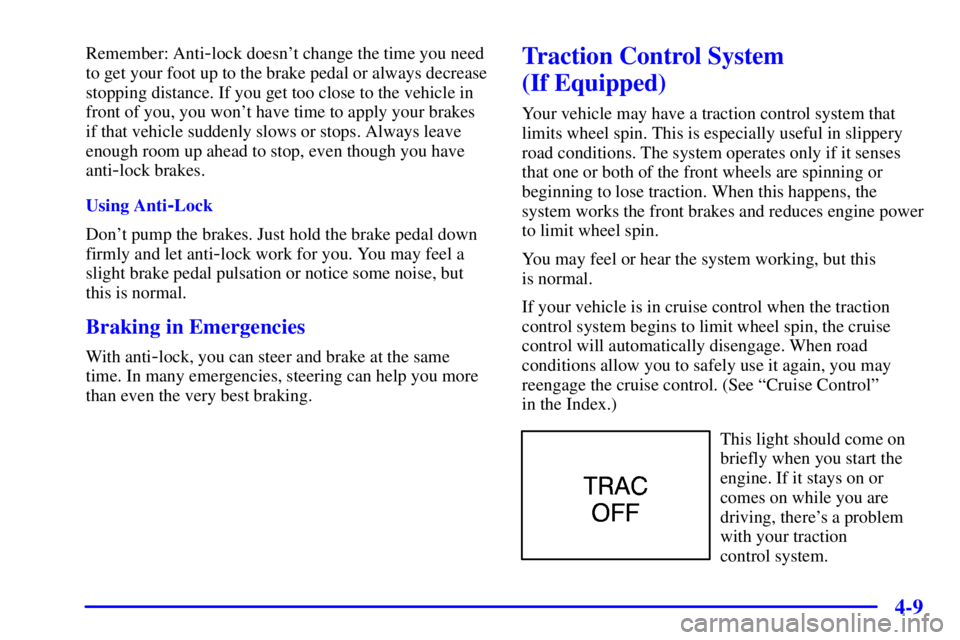2000 PONTIAC BONNEVILLE light
[x] Cancel search: lightPage 176 of 402

3-16
TRAF: Press this button to receive traffic
announcements. The traffic announcement brackets will
appear on the display. TRAF will appear on the display
if the tuned station broadcasts traffic announcements.
If the current tuned station does not broadcast traffic
announcements, the radio will seek to a station that
does. When the radio finds a station that broadcasts
traffic announcements, it will stop. If no station is found,
NO TRAFFIC will appear on the display.
When a traffic announcement comes on the tuned radio
station or a related network station, you will hear it,
even if the volume is muted or a cassette tape or
compact disc is playing. If the cassette tape or compact
disc player was being used, the tape or compact disc will
stay in the player and resume play at the point where
it stopped.
INFO: If the current station has a message, INFO will
appear on the display. Press this button to see the
message. If the whole message does not appear on the
display, parts of the message will appear every three
seconds until the message is completed. To see the parts
of the message faster than every three seconds, press this
button again. A new group of words will appear on the
display. Once the complete message has been displayed,
INFO will disappear from the display until another new
message is received.PROG-TYPE: This button is used to turn on and off
Program Type (PTY) select. The P
-TYPE icon will
appear on the display and the SELECT LED indicator
next to the SELECT knob will light. The last selected
PTY will appear on the display for five seconds. Turn
the SELECT knob to select the PTY you want to listen
to. Press SEEK or SCAN to find radio stations of the
PTY you want to listen to. The last PTY selected will
be used for seek or scan modes. If a station with the
selected PTY is not found, NOT FOUND will appear on
the display. If both PROG
-TYPE and TRAF are on, the
radio will search for stations with traffic announcements
and the selected PTY.
To use the PROG
-TYPE interrupt feature, press and
hold this button until you hear a beep on the PTY
you want to interrupt. An ª*º will appear next to the
PTY name, for example CLASSICAL*. When you are
listening to a cassette or compact disc, the last selected
RDS FM station will interrupt play if that selected PTY
format is broadcast.
Page 182 of 402

3-22
PRESET SCAN: Press and hold one of the SEEK
arrows for more than four seconds until the PSCAN icon
and the preset number appear on the display. You will
hear a double beep. Use PRESET SCAN to listen to
each of your preset stations for a few seconds. The
radio will go to the first preset station stored on your
pushbuttons, stop for a few seconds, then go on to the
next preset station. PRESET SCAN will only scan the
six presets that are in the band selected. Press one of the
SEEK arrows again to stop scanning presets.
Note that PRESET SCAN will skip over presets where
no station is being received at that time to prevent
hearing static.
Setting the Tone
TONE: Press and release this button until the desired
tone control (BASS, MID or TREB) is found. The
SELECT LED indicator will light to show that the tone
control can be adjusted. When using BASS or MID, turn
the SELECT knob clockwise to increase bass. Turn it
counterclockwise to decrease bass. When using TREB,
turn the SELECT knob clockwise to increase treble.
Turn it counterclockwise to decrease treble. If a station
is weak or noisy, you may want to decrease the treble.
To set all of the tone controls to the middle position,
press and hold TONE until FLAT appears on the display.EQ: This feature allows you to choose preset bass,
mid and treble equalization settings designed for
different individual listening tastes. Press EQ to select
the desired preset equalization setting. Each time you
press EQ, another setting will appear on the display.
You can preset up to six equalization settings. Just:
1. Turn the radio on.
2. Use the TONE button and the SELECT knob to
select the desired equalization.
3. Press and hold EQ for two seconds. SELECT EQ #
will appear on the display. The EQ icon will flash.
4. Press EQ or turn the SELECT knob to select the
desired EQ number. Each time you press EQ or turn
the SELECT knob, another EQ setting will appear on
the display.
5. Press and hold the EQ button or push the SELECT
knob to store the equalization preset. You will hear a
beep and EQ SAVED will appear on the display.
6. Repeat the steps for each EQ setting.
Note that EQ 5 has been programmed at the factory
for use with talk radio, but it can be preset to a
different tone.
Page 184 of 402

3-24
PROG-TYPE: This button is used to turn on and off
Program Type (PTY) select. The P
-TYPE icon will
appear on the display and the SELECT LED indicator
next to the SELECT knob will light. The last selected
PTY will appear on the display for five seconds. Turn
the SELECT knob to select the PTY you want to listen
to. Press SEEK or SCAN to find radio stations of the
PTY you want to listen to. The last PTY selected will
be used for seek or scan modes. If a station with the
selected PTY is not found, NOT FOUND will appear on
the display. If both PROG
-TYPE and TRAF are on,
the radio will search for stations with traffic
announcements and the selected PTY.
To use the PROG
-TYPE interrupt feature, press and
hold this button until you hear a beep on the PTY
you want to interrupt. An ª*º will appear next to the
PTY name, for example CLASSICAL*. When you are
listening to a cassette or compact disc, the last selected
RDS FM station will interrupt play if that selected PTY
format is broadcast.PUSHBUTTONS: The six numbered pushbuttons let
you return to your favorite Program Types (PTYs).
These buttons have factory PTY presets. You can set up
to 12 PTYs (six FM1 and six FM2). Just:
1. Press PROG
-TYPE, if it is not already on.
2. Press AM
-FM to select FM1 or FM2.
3. Turn the SELECT knob to select a PROG
-TYPE.
4. Press and hold one of the six numbered buttons until
you hear a beep. Whenever you press that numbered
button, the PTY you set will return.
5. Repeat the steps for each pushbutton.
ALERT!: This type of announcement warns of national
or local emergencies. You will not be able to turn off
alert announcements. ALERT! appears on the display
when an alert announcement plays. When an alert
announcement comes on the tuned radio station, you
will hear it, even if the volume is muted or a cassette
tape or compact disc is playing. If the cassette tape or
compact disc player is playing, play will stop for the
announcement and resume when the announcement
is finished.
Page 188 of 402

3-28
PUSHBUTTONS: The six numbered pushbuttons let
you return to your favorite stations. You can set up to
18 stations (six AM, six FM1 and six FM2). Just:
1. Turn the radio on.
2. Press AM
-FM to select the band.
3. Tune in the desired station.
4. Press EQ to select the equalization.
5. Press and hold one of the six numbered buttons until
you hear a beep. Whenever you press that numbered
button, the station you set will return and the
equalization that you selected will also be
automatically selected for that button.
6. Repeat the steps for each pushbutton.
PRESET SCAN: Press and hold one of the SEEK
arrows for more than four seconds until the PSCAN icon
and the preset number appear on the display. You will
hear a double beep. Use PRESET SCAN to listen to
each of your preset stations for a few seconds. The
radio will go to the first preset station stored on your
pushbuttons, stop for a few seconds, then go on to the
next preset station. Press one of the SEEK arrows again
to stop scanning presets.
Note that PRESET SCAN will skip over presets where
no station is being received at that time to prevent
hearing static.Setting the Tone
TONE: Press and release this button until the desired
tone control (BASS, MID or TREB) is found. The
SELECT LED indicator will light to show that the tone
control can be adjusted. When using BASS or MID, turn
the SELECT knob clockwise to increase bass. Turn it
counterclockwise to decrease bass. When using TREB,
turn the SELECT knob clockwise to increase treble.
Turn it counterclockwise to decrease treble. If a station
is weak or noisy, you may want to decrease the treble.
To set all of the tone controls to the middle position,
press and hold TONE until FLAT appears on the display.
EQ: This feature allows you to choose preset bass,
mid and treble equalization settings designed for
different individual listening tastes. Press EQ to select
the desired preset equalization setting. Each time you
press EQ, another setting will appear on the display.
Page 190 of 402

3-30
TRAF: Press this button to receive traffic
announcements. The traffic announcement brackets will
appear on the display. TRAF will appear on the display
if the tuned station broadcasts traffic announcements.
If the current tuned station does not broadcast traffic
announcements, the radio will seek to a station that
does. When the radio finds a station that broadcasts
traffic announcements, it will stop. If no station is found,
NO TRAFFIC will appear on the display.
When a traffic announcement comes on the tuned radio
station or a related network station, you will hear it,
even if the volume is muted or a cassette tape or
compact disc is playing. If the cassette tape or compact
disc player was being used, the tape or compact disc will
stay in the player and resume play at the point where
it stopped.
INFO: If the current station has a message, INFO will
appear on the display. Press this button to see the
message. If the whole message does not appear on the
display, parts of the message will appear every three
seconds until the message is completed. To see the parts
of the message faster than every three seconds, press this
button again. A new group of words will appear on the
display. Once the complete message has been displayed,
INFO will disappear from the display until another new
message is received.PROG-TYPE: This button is used to turn on and off
Program Type (PTY) select. The P
-TYPE icon will
appear on the display and the SELECT LED indicator
next to the SELECT knob will light. The last selected
PTY will appear on the display for five seconds. Turn
the SELECT knob to select the PTY you want to listen
to. Press SEEK or SCAN to find radio stations of the
PTY you want to listen to. The last PTY selected will be
used for seek or scan modes. If a station with the
selected PTY is not found, NOT FOUND will appear on
the display. If both PROG
-TYPE and TRAF are on, the
radio will search for stations with traffic announcements
and the selected PTY.
To use the PROG
-TYPE interrupt feature, press and
hold this button until you hear a beep on the PTY
you want to interrupt. An ª*º will appear next to the
PTY name, for example CLASSICAL*. When you are
listening to a cassette or compact disc, the last selected
RDS FM station will interrupt play if that selected PTY
format is broadcast.
Page 203 of 402

3-43 Care of Your Cassette Tape Player
A tape player that is not cleaned regularly can cause
reduced sound quality, ruined cassettes or a damaged
mechanism. Cassette tapes should be stored in their
cases away from contaminants, direct sunlight and
extreme heat. If they aren't, they may not operate
properly or may cause failure of the tape player.
Your tape player should be cleaned regularly after every
50 hours of use. Your radio may display CLEAN
PLAYER to indicate that you have used your tape player
for 50 hours without resetting the tape clean timer. If
this message appears on the display, your cassette tape
player needs to be cleaned. It will still play tapes, but
you should clean it as soon as possible to prevent
damage to your tapes and player. If you notice a
reduction in sound quality, try a known good cassette to
see if it is the tape or the tape player at fault. If this other
cassette has no improvement in sound quality, clean the
tape player.
The recommended cleaning method for your cassette
tape player is the use of a scrubbing action,
non
-abrasive cleaning cassette with pads which scrub
the tape head as the hubs of the cleaner cassette turn.
The recommended cleaning cassette is available through
your dealership (GM Part No. 12344789).You may also choose a non
-scrubbing action, wet-type
cleaner which uses a cassette with a fabric belt to clean
the tape head. This type of cleaning cassette will not
eject on its own. A non
-scrubbing action cleaner may
not clean as thoroughly as the scrubbing type cleaner.
The use of a non
-scrubbing action, dry-type cleaning
cassette is not recommended.
After you clean the player, press and hold EJECT for
two seconds to reset the CLEAN PLAYER indicator.
The radio will display CLEANED to show the indicator
was reset.
Cassettes are subject to wear and the sound quality may
degrade over time. Always make sure the cassette tape
is in good condition before you have your tape
player serviced.
Care of Your Compact Discs
Handle discs carefully. Store them in their original cases
or other protective cases and away from direct sunlight
and dust. If the surface of a disc is soiled, dampen a
clean, soft cloth in a mild, neutral detergent solution and
clean it, wiping from the center to the edge.
Be sure never to touch the signal surface when handling
discs. Pick up discs by grasping the outer edges or the
edge of the hole and the outer edge.
Page 211 of 402

4-7
Avoid needless heavy braking. Some people drive in
spurts
-- heavy acceleration followed by heavy
braking
-- rather than keeping pace with traffic.
This is a mistake. Your brakes may not have time to
cool between hard stops. Your brakes will wear out
much faster if you do a lot of heavy braking. If you
keep pace with the traffic and allow realistic following
distances, you will eliminate a lot of unnecessary
braking. That means better braking and longer
brake life.
If your engine ever stops while you're driving, brake
normally but don't pump your brakes. If you do,
the pedal may get harder to push down. If your engine
stops, you will still have some power brake assist.
But you will use it when you brake. Once the power
assist is used up, it may take longer to stop and the
brake pedal will be harder to push.
Anti-Lock Brakes (ABS)
Your vehicle has anti-lock brakes (ABS). ABS is an
advanced electronic braking system that will help
prevent a braking skid.
When you start your engine, or when you begin to drive
away, your anti
-lock brake system will check itself.
You may hear a momentary motor or clicking noise
while this test is going on, and you may even notice that
your brake pedal moves or pulses a little. This is normal.
United States Canada
If there's a problem with the anti
-lock brake system,
this warning light will stay on. See ªAnti
-Lock Brake
System Warning Lightº in the Index.
Page 213 of 402

4-9
Remember: Anti-lock doesn't change the time you need
to get your foot up to the brake pedal or always decrease
stopping distance. If you get too close to the vehicle in
front of you, you won't have time to apply your brakes
if that vehicle suddenly slows or stops. Always leave
enough room up ahead to stop, even though you have
anti
-lock brakes.
Using Anti
-Lock
Don't pump the brakes. Just hold the brake pedal down
firmly and let anti
-lock work for you. You may feel a
slight brake pedal pulsation or notice some noise, but
this is normal.
Braking in Emergencies
With anti-lock, you can steer and brake at the same
time. In many emergencies, steering can help you more
than even the very best braking.
Traction Control System
(If Equipped)
Your vehicle may have a traction control system that
limits wheel spin. This is especially useful in slippery
road conditions. The system operates only if it senses
that one or both of the front wheels are spinning or
beginning to lose traction. When this happens, the
system works the front brakes and reduces engine power
to limit wheel spin.
You may feel or hear the system working, but this
is normal.
If your vehicle is in cruise control when the traction
control system begins to limit wheel spin, the cruise
control will automatically disengage. When road
conditions allow you to safely use it again, you may
reengage the cruise control. (See ªCruise Controlº
in the Index.)
This light should come on
briefly when you start the
engine. If it stays on or
comes on while you are
driving, there's a problem
with your traction
control system.